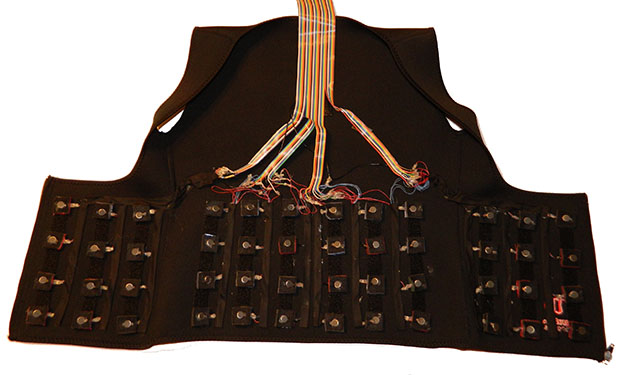For his entry to The Hackady Prize, [Sean] is building a haptic vest for gamers and the visually impaired. It’s exactly what you think it is: a vest with proximity sensors and motors that wrap around the wearer, providing haptic feedback of nearby obstacles. Actually building a vest with a few dozen motors is a bit of a challenge, and that’s why this project is in the running for The Hackaday Prize.
Each of the 48 motors are individually controllable with PWM. In any other project, this would require a few dozen microcontrollers or one with a whole lot of pins. [Sean], however, is using LED drivers. They do exactly what [Sean] needs them to do – an easy to interface way of a whole bunch of PWM lines – and they do it cheaper than any other solution.
For detecting objects surrounding the vest, [Sean] is using the depth sensor on a 1st gen Microsoft Kinect. In testing, [Sean] blindfolded a volunteer and had a few friends move around with cardboard ‘obstacles.’ The volunteer successfully avoided all the obstacles, as seen in the video below.
 The project featured in this post is a quarterfinalist in The Hackaday Prize.
The project featured in this post is a quarterfinalist in The Hackaday Prize.















Cool project, I’d like to try the west on myself.
But the contest requirement of “It must transmit data to and/or from another device” is definitely applied to it’s maximum outer limits here. Connecting a regular webcam to the USB port of a RaspberryPi should also be ok according to this lax interpretation.
I think the strictness of the interpretation of the contest rules is inversely interpreted in accordance with the coolness of the entry.
Agreed. Vibrating pants would have been *much* cooler.
Would this not be a health issue?
One could change or upset one’s heart beat!!!
I wonder what the insurance companies think about the liabilities involved with this device!
I would seek medical advice before using it… you never know if a medical issue pop’s it’s ugly head when you are trying to have fun!
Having vibrating motors on your body is not a health issue. You have them in your cellphones. They’re in your gaming controllers.
One for the Cell Phone… In Front or Rear pocket
Maybe a couple for the gaming controller… It is in your hands
Not 48 of them ALL going off at the same time… ;^( Strap tightly on your chest
No info on the magnetic wave it is introducing to body cavity… It would influence the blood flow in chest area… This device would promote blood clotting by trapping iron in the blood vessels… Heart attack by PWM not cool at all!
Are you some kind of stupid or just a troll? There are no “magnetic waves” to speak of from a tiny motor. And blood is not really that magnetic.
I guess that you don’t believe in all the ‘alternative medicine’ treatments with magnetic bracelets, rings and whatnots? That’s good, because science says that they are pure bullshit.
But if you are afraid of magnetic fields I suggest you try to keep away from getting a MRI done at a hospital. The magnetic fields in that machine is “millions” of times stronger than what you ever will get outside of a tiny motor. A MRI would kill you dead instantly according to your beliefs.
The magnetic field next to a 1500 watt motor is approx 100uT, a MRI is between 1000 000 and 3000 000 uT (1-3T). The magnetic field from a 0.1 watt vibration motor is certainly a lot less than 100uT.
Using a led driver for PWMing the motors is smart. I wonder if that also could be applied to regular servos as well. I led driver with 10 or 12 bit resolution would probably be necessary due to the limited range of pwm ratios a servo accepts.
Adafruit sells a PCA9685 breakout board as a “PWM/Servo Shield”, the official documentation calls it a “16-channel, 12-bit PWM Fm+ I2C-bus LED controller”
Thanks, I didn’t know (obviously ^_^) about that board and the usage of PCA9685 for servo handling. That will come in handy some day.
good luck waring that through air post security.
This haptic feedback is da bomb!
*gets tackled*
@Ross Reed
This made me laugh. :D
I don’t see the recirculation diodes. Isn’t that needed when PWMing a motor (regardless how small it is)?
Would this eventually wear the LED drivers out b/c of the flyback voltage from the motors? I’m sure it would work for a time as a proof of concept I’m just wondering about long term use and high quantity consumer product.
Would a flyback diode fix that or how would I encounter this?
Makes me think of the dress Dr. Miranda Jones wore in the Star Trek Episode: “No Truth in Beauty”
This, an oculus rift and an omni treadmil would make for the best VR combo, if someone found out a way to interface it to a game.
Just imagine playing a FPS and feeling avibration on the part of the body where you get shot.
Brilliant. Saw a smaller version of this over the summer, not nearly as many sensors. Just wondering… as clarification, may be obvious, maybe I just missed it… this basically uses ultrasonic sensors hooked up to motors, all sensors programmed to send a vibrate signal to motors when a specific distance value is read, right?
Two questions:
Could this be done without too much hassle for this many sensors and motors with an Arduino UNO? perhaps a MEGA?
Also, could the distance at which the sensors activate be easily modified, like with a set of switches for different read values? just curious, perhaps this has been accomplished already with different strength vibrations of motors. Just some thoughts, feel free to tear at them.